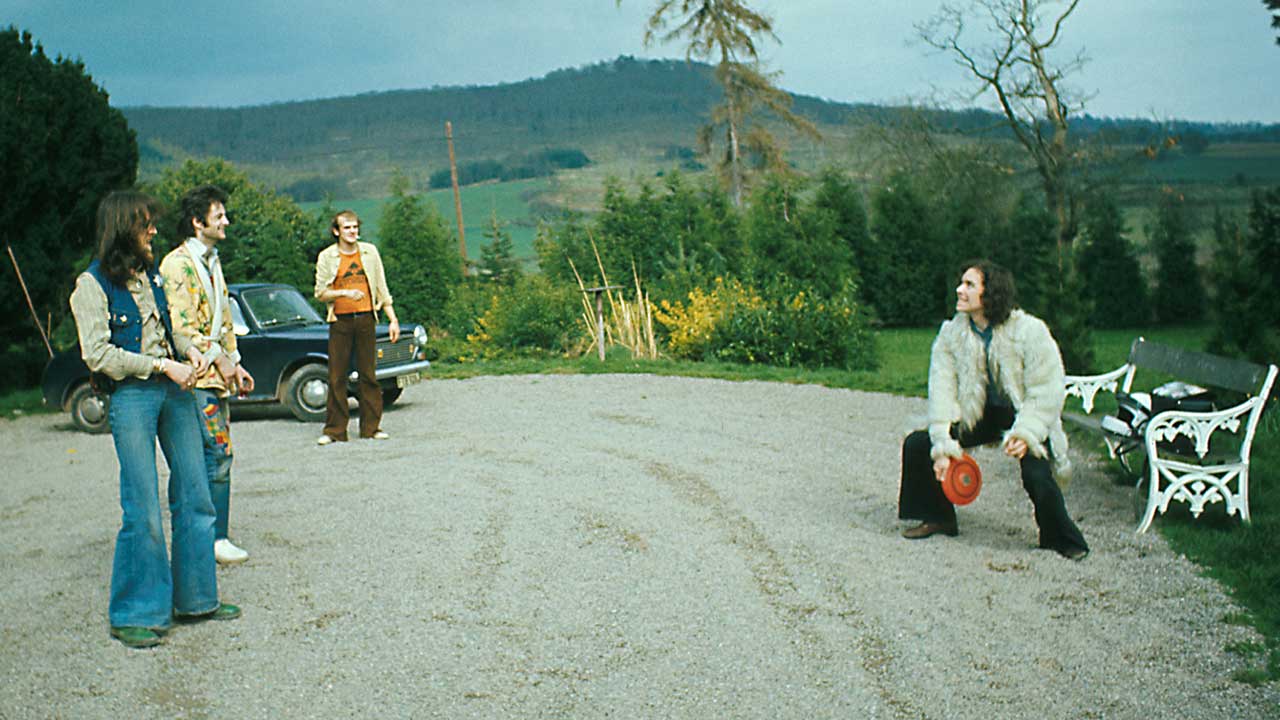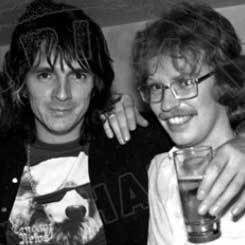Of course, they could have been called Zeiss Manifold & The Shrieking Plasma, or any one of a hundred or more different names that founder member Chris Judge Smith collected, for no apparent reason, in his notebook. But the marginally less obscure title of Van Der Graaf Generator won through in the end, and so it was that in 1967 at Manchester University a band was born.
Comprising, besides Smith, Nick Pearne and, most notably, Peter Hammill, Van Der Graaf Generator – in reality a particle accelerator used in atomic research, medicine and industry, invented by US physicist Robert J Van de Graaff – were really no more than your typical, experimental college band with few aspirations for the future.
“It was very much Mark One,” Hammill told this writer in 1975. Later, in 1968, the band underwent its first personnel change: Hugh Banton, a keyboard player, replaced Pearne. Subsequently, a few abortive recordings were made and a complex series of band interrelationships began. Guy Evans, drummer, joined. Judge Smith left to form a band called Heebalob with saxophone player David Jackson, who would later join VDGG themselves. Keith Ellis joined on bass, then left to join Juicy Lucy.
The band went on the road for a year. Then they broke up “for a number of reasons,” said Hammill, “among which personality conflicts figured not at all”. But Hammill, the band’s leader and guiding light, his melancholic, soul-searching poetical power as yet in a formative stage, was by now committed to music. He began to play one-off solo acoustic gigs and in 1969 secured a record contract with the Mercury label.
Hammill had 12 hours of studio time booked to record a solo LP. He asked three of his friends – Evans, Ellis and Banton – to contribute to the making of it, which they did. “And somewhere amid all the chaos of people, instruments, empty bottles and plastic cups, Van Der Graaf Generator was reborn,” stated Hammill.
Ultimately, a band album emerged: Aerosol Grey Machine. Listening to it, you’re able to recognise the band’s potential: the songs are strangely structured animals, lightweight and yet at the same time unwieldy, made edgy thorough VDGG’s curious instrumentation. Embracing it all is Hammill’s haunting and extraordinarily graphic lyricism, enhanced by his unconventional vocal phrasing.
“This period at the end of 1969,” recalled Hammill, “was a very nebulous one. There was a lot of coming together, a lot of poverty, but there was a great deal of force. There was something happening.”
There was also a single, People You Were Going To/Firebrand, and a few isolated British gigs. But before long the ‘real’ VDGG were back in the studio, for four days this time, with a crisp new Charisma contract in hand, to record The Least We Can Do Is Wave To Each Other with newfound bassist Nic Potter.
By now, ideas were developing and maturing, atmospheres, ranging from hopelessness to hopefulness, from the sinister to the puzzling, were being conjured successfully. And classic tracks – Refugees, White Hammer – were in the making.
An album of many moods and great variation, The Least… finally emerged in March 1970. The critics received it with uncertainty – and a good deal of incomprehension. At that time an adventurous young label, Charisma put together a British package tour that, as well as VDGG, featured two of its other bands: Genesis and Lindisfarne.
VDGG were greeted with great enthusiasm or else encountered total apathy during the tour. The band’s appeal – or lack of it – remains divisive to this day. In mid-1970 a second/third album was recorded, the mysteriously titled He To He, Who Am The Only One.
Nic Potter left during the sessions and by the time of the LP’s December release, VDGG’s roster had become Hammill, acoustic guitar and vocals; Banton, keyboards; Jackson, sax and flute; and Evans, drums. This is now regarded as the band’s ‘classic’ line-up.
However, Hammill had accumulated a collection of songs that, he felt, would be out of place if played in a band context, and so in April 1971 he recorded his first true solo album: Fool’s Mate.
Later in that year, in November, the definitive VDGG album was issued: Pawn Hearts. It contained the band’s masterwork: the epic A Plague Of Lighthouse Keepers, the macabre and tragic story of shipwrecks and the deaths of innumerable sailors, and it took up a whole side of the original vinyl release.
This immense work spans the spectrum of human emotion: the listener experiences complete desolation, reacts to the sheer terror of drowning, then becomes relieved as extreme fear is transformed into utter peacefulness
“The story deals with the guilt felt by a lighthouse keeper and his complexes about seeing people die and not being able to help,” Hammill once said. “In the end he either kills himself, or he rationalises it all and can live in peace.” It’s up to the listener to decide.
“When we recorded Pawn Hearts,” recalled Guy Evans, “we experienced more real, uh, heavy conflict between ourselves than we ever had done before. It produced a good result, but it placed the band in a difficult position. We just didn’t know where to go from there.”
VDGG split and Hammill embarked on a solo career, producing albums of disturbing brilliance such as Chameleon In the Shadow Of The Night (1973) and Nadir’s Big Chance (1975), a bizarre amalgam of prog and punk; John Lydon has since cited Hammill’s existential lyrics and tortured vocal style as a major influence.
Towards the end of 1974, Hammill, Evans, Jackson and Banton discussed the possibility of re-forming VDGG. “The lay-off was necessary to enable the rest of the world to catch up,” chuckled IMP/LFI Charisma boss Tony Stratton Smith.
The resultant album, 1975’s Godbluff, contained just four tracks: Undercover Man, Scorched Earth, Arrow and The Sleepwalkers. Each was inventive and experimental, chilling and jarring. VDGG were back at the top of the game.
More albums, more personnel changes and a shortening of the band’s name – to Van Der Graaf – followed before Hammill again embarked on a solo career. Long years passed before, in December 2003, he was laid low by a heart attack. Shortly afterward, in 2005, the prog community was stunned by the news that the classic VDGG line-up of Hammill, Banton, Jackson and Evans was reforming.
“People have always been badgering us to reunite over the years,” Hammill told this writer at the time. “We kept on bumping into each other at funerals for old roadies of ours. I guess that’s when the idea first surfaced.”
VDGG remain active as a trio, Jackson having bowed out of the ranks in 2006, and latest album Do Not Disturb was released in September 2016. It might be their final acts, but if not? Catch them before it’s too late… before visions shimmer and fade out of the glass.

Why I ❤️ Van der Graaf Generator, by Iron Maiden's Brice Dickinson
“Peter Hammill was an old boy at my school… so was VDGG saxophonist David Jackson I believe. They put VDGG together there, and they played a gig at the school when I was 15-years-old. A VDGG album such as Pawn Hearts is not a million miles away from Maiden stuff such as Rime Of The Ancient Mariner.
“I have to confess there’s a bit of a nod to VDGG on [Maiden’s 2006 album] A Matter Of Life And Death. On Brighter Than A Thousand Suns there’s a line that goes: 'Whatever would Robert have said to his God/About how we made war with the sun.” And there’s a track called Whatever Would Robert Have Said on VDGG’s The Least We Can Do Is Wave To Each Other [the "Robert" in question is J. Robert Oppenheimer, the so-called father of the atomic bomb].
“Albert Einstein once made a comment about the arms race: ‘Every step appears to be the unavoidable consequence of the preceding one, and in the end there beckons more and more clearly total annihilation.’
"Well, Hammill used those exact words at the end of another VDGG track, After The Flood. And I mention Einstein’s theory E=MC2 on Brighter Than A Thousand Suns. So it’s all bomb-related, really."

